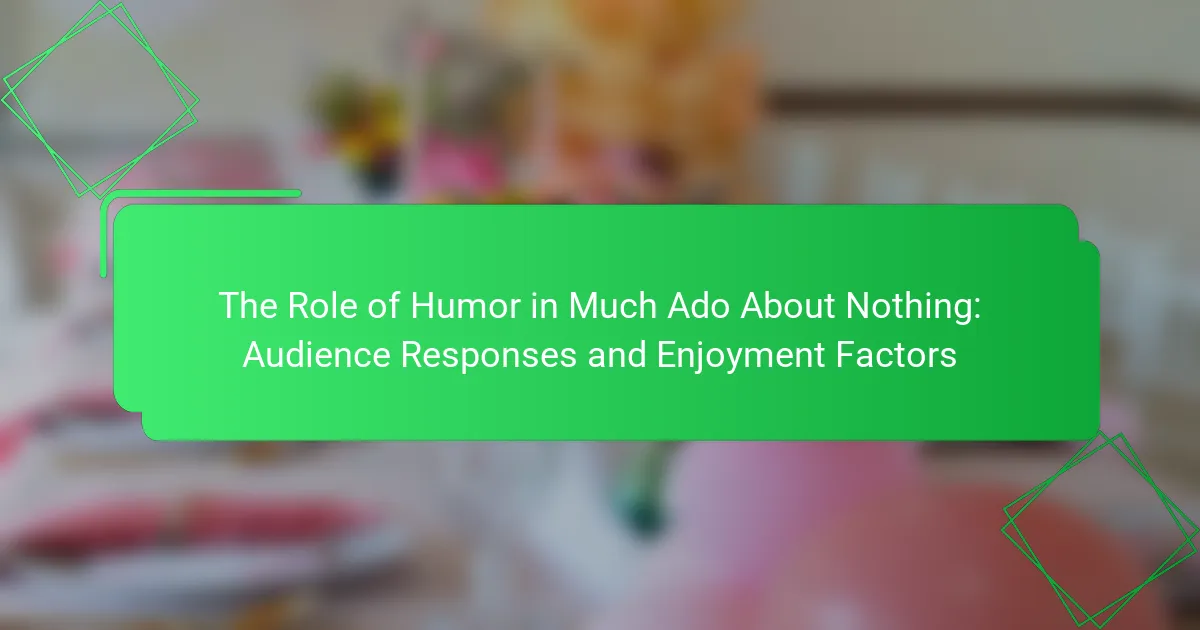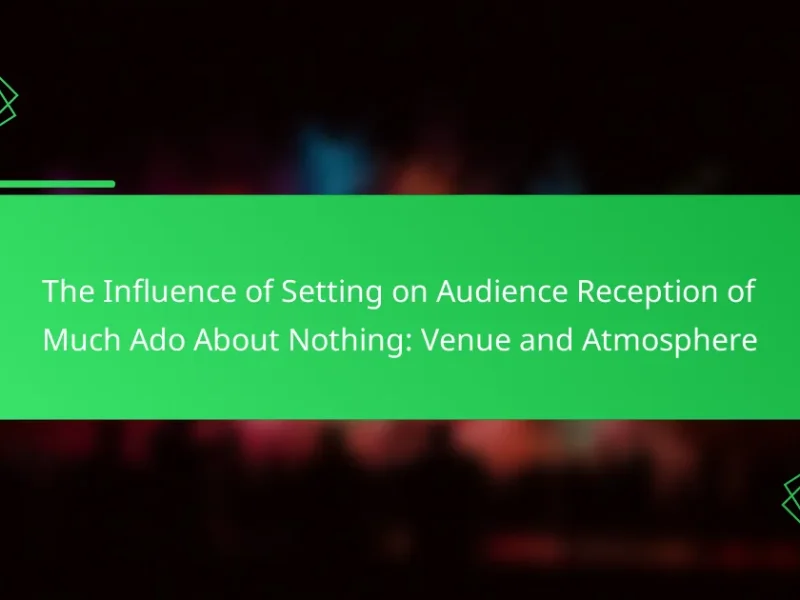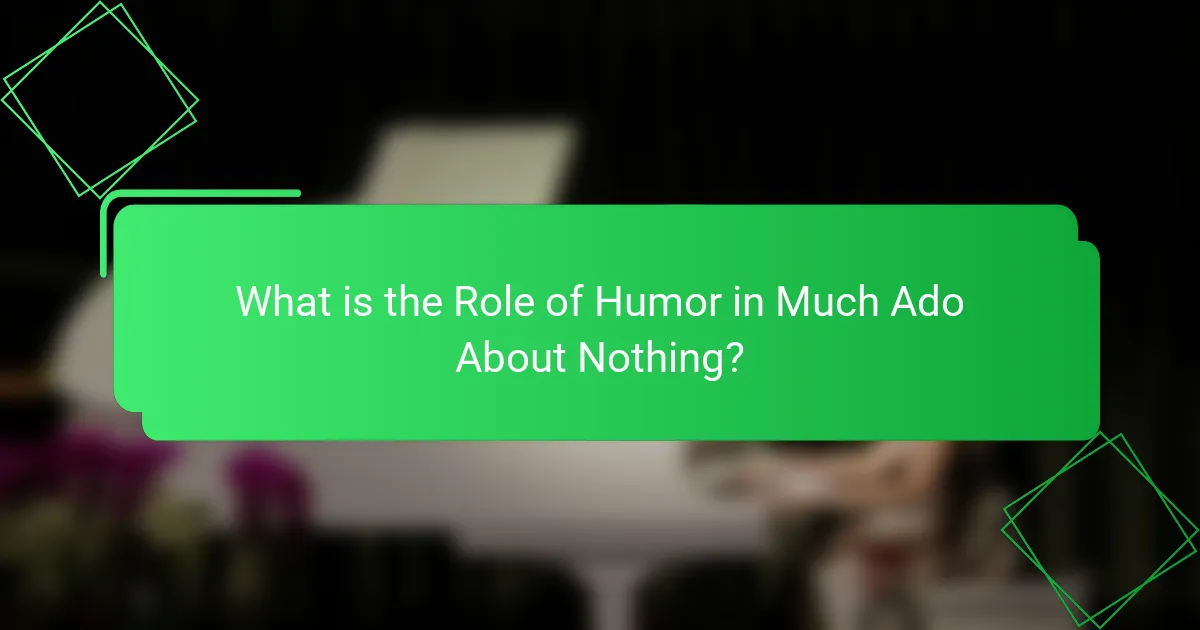
What is the Role of Humor in Much Ado About Nothing?
Humor plays a crucial role in “Much Ado About Nothing.” It serves to enhance the entertainment value of the play. The witty banter between characters, particularly Beatrice and Benedick, creates comedic tension. This humor also acts as a vehicle for social commentary on relationships and gender roles. Additionally, misunderstandings and deceptions generate comedic situations that drive the plot forward. The use of puns and wordplay adds layers to the humor, engaging the audience. Ultimately, humor in the play fosters audience enjoyment and facilitates deeper connections with its themes.
How does humor influence audience responses in Much Ado About Nothing?
Humor significantly influences audience responses in Much Ado About Nothing. It engages the audience by creating a sense of enjoyment and connection with the characters. The witty banter between Beatrice and Benedick showcases clever wordplay that captivates viewers. This exchange highlights the play’s comedic elements, making the audience laugh and relate to their dynamic. Additionally, the humorous misunderstandings and deceptions, such as the plot to make Benedick and Beatrice fall in love, enhance the entertainment value. These comedic devices evoke a range of emotions, from amusement to empathy, deepening audience investment in the characters’ journeys. Ultimately, humor serves as a crucial mechanism for audience engagement in the play.
What types of humor are present in Much Ado About Nothing?
Much Ado About Nothing features several types of humor. These include wordplay, situational comedy, and character-based humor. Wordplay is evident in the witty banter between characters, particularly Beatrice and Benedick. Their exchanges showcase puns and clever language. Situational comedy arises from misunderstandings and mistaken identities, such as the deception involving Claudio and Hero. Character-based humor is prominent through the eccentricities of characters like Dogberry. His malapropisms contribute to the comedic effect. These humor types enhance the play’s entertainment value and engage the audience effectively.
How do different characters utilize humor in the play?
Different characters utilize humor in “Much Ado About Nothing” to convey wit, create tension, and engage the audience. Benedick often employs clever wordplay and banter to showcase his intelligence and charm. Beatrice matches him with her sharp tongue, creating a comedic dynamic that highlights their romantic tension. Dogberry, the constable, provides physical comedy and malapropisms, generating laughter through his incompetence. Claudio and Hero’s relationship includes humorous misunderstandings that reflect social norms. The humor serves to critique societal expectations and enhance character relationships. This multifaceted use of humor keeps the audience entertained while deepening the narrative.
Why is humor significant to the enjoyment of Much Ado About Nothing?
Humor is significant to the enjoyment of Much Ado About Nothing because it enhances the play’s appeal and engages the audience. The witty banter between characters creates a lively atmosphere. This clever dialogue often reflects human follies and societal norms. It allows the audience to connect with the characters on a personal level. The comedic elements provide relief from the play’s tension and drama. For instance, the misunderstandings and deceptions lead to humorous situations. These moments resonate with the audience, making the narrative more enjoyable. Ultimately, humor serves as a vehicle for deeper themes, enriching the overall experience of the play.
What emotional responses does humor evoke in the audience?
Humor evokes a range of emotional responses in the audience, primarily laughter and joy. Laughter serves as a social bonding mechanism, enhancing group cohesion. Joy from humor can lead to increased feelings of happiness and relaxation. Additionally, humor can evoke surprise, which stimulates curiosity and engagement. It often provides relief from tension, allowing audiences to experience catharsis. Research indicates that humor activates brain regions associated with pleasure, further confirming its positive emotional impact. In “Much Ado About Nothing,” humor effectively elicits these responses, contributing to the overall enjoyment of the play.
How does humor enhance the themes of love and deception in the play?
Humor enhances the themes of love and deception in the play by creating a light-hearted atmosphere that allows for deeper exploration of serious topics. In “Much Ado About Nothing,” witty banter between characters highlights romantic tensions. For instance, the playful exchanges between Beatrice and Benedick reveal their true feelings while masking their vulnerabilities. Additionally, humorous misunderstandings, such as the plot to deceive Claudio regarding Hero’s fidelity, underscore the fragility of love. This comedic framing allows the audience to engage with the themes without feeling overwhelmed by the weight of deception. Ultimately, humor serves as a vehicle for both critique and celebration of love, making the complex dynamics more accessible and enjoyable for the audience.
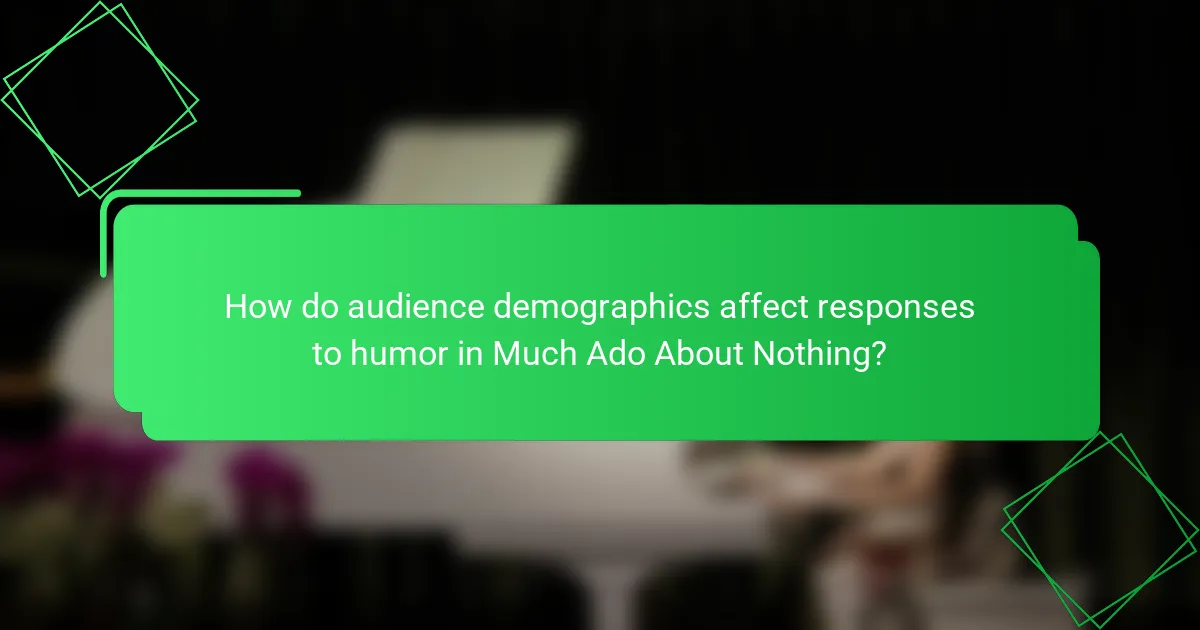
How do audience demographics affect responses to humor in Much Ado About Nothing?
Audience demographics significantly influence responses to humor in Much Ado About Nothing. Factors such as age, cultural background, and social context shape humor perception. Younger audiences may resonate more with physical comedy and contemporary references. In contrast, older audiences might appreciate wordplay and situational irony. Cultural background affects humor appreciation, with diverse groups interpreting jokes differently. For instance, references to societal norms may elicit varied responses based on cultural context. Studies show that familiarity with Shakespearean language enhances humor appreciation among educated audiences. Therefore, demographic variations lead to diverse interpretations and enjoyment of humor in the play.
What role do cultural backgrounds play in interpreting humor?
Cultural backgrounds significantly influence how humor is interpreted. Different cultures have distinct values, norms, and experiences that shape comedic preferences. For instance, humor based on wordplay may resonate differently across languages. A joke that relies on cultural references may be lost on those outside that culture. Research indicates that shared cultural experiences enhance comedic understanding. Studies show that humor often reflects societal issues, making it context-dependent. This underscores the importance of cultural context in humor appreciation. Understanding these nuances can enhance audience engagement in works like “Much Ado About Nothing.”
How does age influence the appreciation of humor in the play?
Age influences the appreciation of humor in the play by affecting the audience’s life experiences and cultural references. Younger audiences may find certain jokes relatable due to their current social contexts. Older audiences might appreciate humor that reflects their experiences or historical contexts. Research indicates that humor appreciation can vary significantly across age groups. A study by Martin et al. (2003) found that older adults often prefer humor that is less aggressive and more situational. This suggests that age shapes not only what is funny but also how humor is perceived in the context of Much Ado About Nothing.
What are the differences in humor reception among various audience groups?
Differences in humor reception among various audience groups can be significant. Factors such as age, cultural background, and personal experiences influence humor appreciation. For instance, younger audiences may prefer slapstick and absurd humor. In contrast, older audiences may favor wit and wordplay. Cultural context also plays a crucial role. Humor that resonates in one culture may not translate well to another. Research shows that shared experiences enhance humor reception. Studies indicate that audiences with common backgrounds find humor more relatable. This relatability fosters a stronger emotional connection to the humor presented.
How does the historical context impact the humor in Much Ado About Nothing?
The historical context of Much Ado About Nothing significantly influences its humor. The play was written during the Elizabethan era, a time marked by strict social norms and gender roles. These societal expectations create a backdrop for the comedic misunderstandings and witty banter between characters.
For example, the play’s humor often derives from the courtship rituals and the expectations of women, which resonate with contemporary audiences familiar with these norms. Additionally, the use of wordplay and puns reflects the Renaissance fascination with language and intellect.
The historical context also shapes the themes of honor and reputation, which are central to the humor. Characters navigate these themes through comedic situations that expose the absurdity of their social constructs. Thus, the humor in Much Ado About Nothing is deeply intertwined with its historical setting, enhancing its comedic impact.
What societal norms are reflected in the humor of the play?
The humor in “Much Ado About Nothing” reflects societal norms related to gender roles and social class. The play demonstrates the expectations placed on men and women in Elizabethan society. For instance, the witty banter between Beatrice and Benedick highlights the norm of courtship as a battle of wits. Their interactions challenge traditional gender roles by showcasing a strong female character who is equal to her male counterpart. Additionally, the humor surrounding characters like Dogberry illustrates class dynamics. His malapropisms and foolishness expose the incompetence of those in authority. The play uses humor to critique the societal expectations of intelligence and social standing. These comedic elements reveal the absurdity of rigid social hierarchies. Overall, the humor serves as a lens through which the audience can examine and question societal norms of the time.
How does the Elizabethan era’s perception of humor differ from modern views?
The Elizabethan era’s perception of humor was heavily influenced by social class and morality. Humor often relied on wordplay, puns, and physical comedy. It served to entertain while also reflecting societal norms and values. In contrast, modern views of humor are more diverse and inclusive. Contemporary humor often embraces irony, satire, and self-deprecation. Additionally, modern audiences may prioritize personal relatability over societal commentary. This shift highlights a broader acceptance of different comedic styles today. Historical context shows that Elizabethan humor was often linked to the hierarchical structure of society. In contrast, modern humor can challenge authority and question social norms.
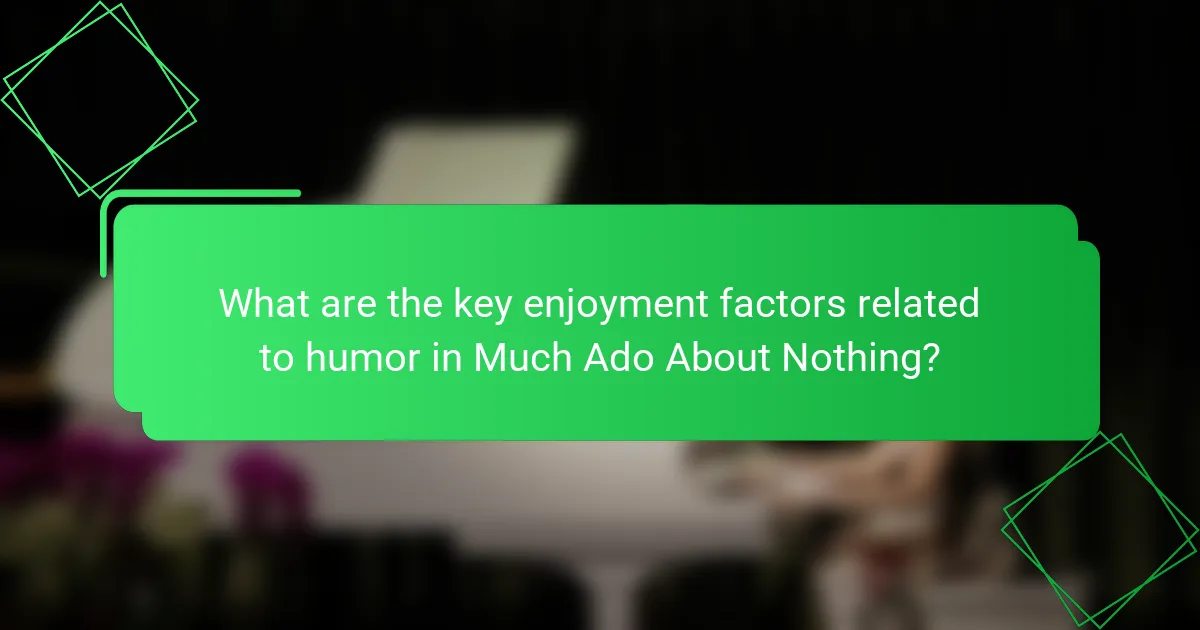
What are the key enjoyment factors related to humor in Much Ado About Nothing?
The key enjoyment factors related to humor in Much Ado About Nothing include wit, wordplay, and situational comedy. Wit is displayed through the sharp banter between characters, particularly Beatrice and Benedick. Their exchanges create a lively atmosphere that engages the audience. Wordplay adds layers of meaning, enhancing the humor through puns and double entendres. Situational comedy arises from misunderstandings and mistaken identities, which are central to the plot. These comedic elements keep the audience entertained and invested in the characters’ relationships. The humor often serves to highlight themes of love and deception in the play. Overall, these factors contribute to the enjoyment and appreciation of the work.
How does timing contribute to the effectiveness of humor in the play?
Timing significantly enhances the effectiveness of humor in the play. Precise timing allows for punchlines to land at the right moment, maximizing audience reaction. Characters often deliver witty remarks immediately after a setup, creating a rhythm that heightens comedic impact. For instance, in Much Ado About Nothing, the rapid exchanges between Beatrice and Benedick showcase how timing amplifies their banter. The quick back-and-forth creates a lively atmosphere that engages the audience. Additionally, pauses before a punchline can build anticipation, leading to a stronger comedic payoff. Thus, effective timing is crucial for humor to resonate with the audience, as evidenced by the play’s successful comedic moments.
What specific scenes exemplify effective comedic timing?
Effective comedic timing in “Much Ado About Nothing” is exemplified in several key scenes. One notable scene occurs during the verbal sparring between Beatrice and Benedick. Their rapid exchanges highlight wit and humor, showcasing impeccable timing. Another significant scene is the masked ball where mistaken identities create humorous misunderstandings. The timing of the reveals adds to the comedic effect. Additionally, Dogberry’s malapropisms provide humor through his character’s timing and delivery. These scenes illustrate how timing enhances the comedic elements in the play, engaging the audience effectively.
How do physical comedy and wordplay enhance audience enjoyment?
Physical comedy and wordplay significantly enhance audience enjoyment by engaging different cognitive and emotional responses. Physical comedy relies on visual gags, exaggerated movements, and slapstick humor. These elements create immediate laughter through surprise and absurdity. Research indicates that visual humor activates the brain’s reward pathways, leading to increased enjoyment.
Wordplay, including puns and clever dialogue, stimulates intellectual engagement. It encourages audiences to think critically about language and meanings. This type of humor fosters a sense of connection among viewers as they share in the wit. Studies show that audiences appreciate clever wordplay, as it showcases the intelligence of the characters and the playwright.
Together, physical comedy and wordplay create a multifaceted comedic experience. They cater to diverse tastes and preferences within the audience. This combination enhances overall enjoyment by balancing visual stimulation with intellectual engagement.
What are some common misconceptions about humor in Much Ado About Nothing?
Common misconceptions about humor in Much Ado About Nothing include the belief that it is solely romantic. While romance is a significant theme, humor also arises from wit and wordplay. Another misconception is that humor is only found in the interactions between Beatrice and Benedick. In fact, humor permeates various character interactions, including those of Dogberry and the Watch. Some audiences think the humor is outdated and irrelevant. However, many comedic elements, such as misunderstandings and social commentary, remain relatable today. Additionally, people often overlook the role of situational comedy. The plot’s misunderstandings create comedic tension that drives the narrative. These misconceptions can limit the appreciation of the play’s rich comedic layers.
How do these misconceptions affect audience engagement?
Misconceptions about humor in “Much Ado About Nothing” negatively impact audience engagement. When audiences misunderstand the comedic elements, they may not fully appreciate the play’s nuances. This leads to a disconnect between the audience’s expectations and the playwright’s intentions. For instance, if viewers perceive humor as outdated or irrelevant, they may disengage from the narrative. Studies show that effective humor enhances emotional connections, fostering greater audience involvement. When humor is misinterpreted, it undermines the relational dynamics between characters, leading to diminished enjoyment. Consequently, misconceptions can result in a less immersive experience for the audience.
What can be done to address these misconceptions for better appreciation?
To address misconceptions about humor in “Much Ado About Nothing,” educational initiatives can be implemented. Workshops and discussions can clarify how humor enhances themes and character development. Analyzing specific scenes can illustrate the comedic techniques used by Shakespeare. Engaging audiences through interactive performances can foster a deeper understanding of humor’s role. Scholarly articles can provide insights into audience responses to humor. Research shows that contextual knowledge increases appreciation of comedic elements in literature. These strategies can lead to a more nuanced appreciation of the play’s humor.
What practical tips can enhance the understanding of humor in Much Ado About Nothing?
To enhance the understanding of humor in Much Ado About Nothing, focus on the context of the Elizabethan era. Understanding the social norms and language of the time can clarify many jokes. Familiarize yourself with the wordplay and puns used throughout the play. Shakespeare often employs double entendres that require careful reading to appreciate fully. Analyze character interactions, especially between Beatrice and Benedick, as their witty banter exemplifies the play’s humor. Watching performances can also help, as actors bring the text to life. Engaging with critical essays on the play provides deeper insights into its comedic elements. Lastly, discussing the play with others can reveal different interpretations of humor.
The main entity of this article is humor in “Much Ado About Nothing.” The article explores the critical role humor plays in enhancing the play’s entertainment value, engaging the audience, and facilitating deeper connections with its themes, particularly love and deception. It examines various types of humor present in the play, including wordplay, situational comedy, and character-based humor, while also addressing how different characters utilize humor to convey wit and create tension. Additionally, the article discusses the influence of audience demographics and cultural backgrounds on humor perception, as well as common misconceptions that may affect audience engagement. Overall, it highlights the significance of humor in enriching the audience’s experience of the play.
